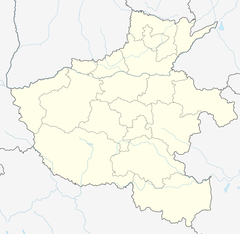
Back معبد شاولين Arabic Shaolin AST Şaolin Azerbaijani شائولین معبدی AZB Шаалінь Byelorussian Шаолин Bulgarian ཧྲའོ་ལིན་དགོན་པ། Tibetan Monestir Shaolin Catalan پەرستگای شاوڵین CKB Klášter Šaolin Czech
This article contains promotional content. (June 2023) |
| Shaolin Monastery | |
|---|---|
少林寺 | |
 Mahavira Hall, the monastery's main building, in 2007 | |
| Religion | |
| Affiliation | Chan Buddhism |
| Status | Active |
| Location | |
| Location | Dengfeng, Zhengzhou, Henan, China |
| Geographic coordinates | 34°30′29″N 112°56′07″E / 34.508141°N 112.935396°E |
| Architecture | |
| Style | Chinese architecture |
| Date established | 495 |
| Website | |
| shaolin | |
| Location | China |
| Part of | Historic Monuments of Dengfeng in "The Centre of Heaven and Earth" |
| Criteria | Cultural: (iv) |
| Reference | 1305-005 |
| Inscription | 2010 (34th Session) |
| Shaolin Monastery | |||||||||||||||||||||||||||
|---|---|---|---|---|---|---|---|---|---|---|---|---|---|---|---|---|---|---|---|---|---|---|---|---|---|---|---|
"Shaolin Temple" in Chinese | |||||||||||||||||||||||||||
| Chinese | 少林寺 | ||||||||||||||||||||||||||
| Literal meaning | "Temple of Shao[shi Mountain] Woods" | ||||||||||||||||||||||||||
| |||||||||||||||||||||||||||
Shaolin Monastery (少林寺; shàolínsì), also known as Shaolin Temple, is a monastic institution recognized as the birthplace of Chan Buddhism and the cradle of Shaolin kung fu.[1] It is located at the foot of Wuru Peak of the Songshan mountain range in Dengfeng County, Henan province, China. The name reflects its location in the ancient grove (林; lín) of Mount Shaoshi, in the hinterland of the Songshan mountains.[i] Mount Song occupied a prominent position among Chinese sacred mountains as early as the 1st century BC, when it was proclaimed one of the Five Holy Peaks (五岳; wǔyuè).[2] It is located some 48 km (30 mi) southeast of Luoyang, the former capital of the Northern Wei Dynasty (386–534), and 72 km (45 mi) southwest of Zhengzhou, the modern capital of Henan Province.[3]
As the first Shaolin abbot, Butuo Buddhabhadra devoted himself to translating Buddhist scriptures and preaching doctrines to hundreds of his followers. According to legend, Bodhidharma, the 28th patriarch of Mahayana Buddhism in India, arrived at the Shaolin Temple in 527. He spent nine years meditating in a cave of the Wuru Peak and initiated the Chinese Chan tradition at the Shaolin Temple. Thereafter, Bodhidharma was honored as the first patriarch of Chan Buddhism.[4][5][6]
The Temple's historical architectural complex, standing out for its great aesthetic value and its profound cultural connotations, has been inscribed in the UNESCO World Heritage List. Apart from its contribution to the development of Chinese Buddhism, as well as for its historical, cultural, and artistic heritage, the temple is famous for its martial arts tradition.[3] Shaolin monks have been devoted to research, creation, and continuous development and perfecting of Shaolin Kung Fu.
The main pillars of Shaolin culture are Chan Buddhism (禅; chán), martial arts (武; wǔ), Buddhist art (艺; yì), and traditional Chinese medicine (医; yī). This cultural heritage, still constituting the daily temple life, is representative of Chinese civilization. A large number of prominent people, eminent monks, Buddhist disciples, and many others, visit the temple for pilgrimage and cultural exchanges. In addition, owing to the work of official Shaolin overseas cultural centers and foreign disciples, Shaolin culture has spread around the world as a distinctive symbol of Chinese culture and a means of foreign cultural exchange.[7]
- ^ "Shaolin Temple | History, Description, & Facts | Britannica". britannica.com. Retrieved 21 December 2024.
- ^ Shahar 2008, pp. 10–11
- ^ a b Shahar 2008, p. 9
- ^ "Shaolin Monk Corps--Shaolin Temple". www.shaolin.org.cn. Archived from the original on 26 January 2023. Retrieved 26 August 2021.
- ^ "Chinese Religions and Philosophies". education.nationalgeographic.org. Retrieved 7 November 2024.
- ^ "The Interaction of Taoism and Buddhism in the Chinese Culture" (PDF). PDF.
- ^ "2024 Shaolin Games: A Gathering of Cultures and Traditions". PR Newswire. 17 July 2024. Retrieved 27 July 2024.
Cite error: There are <ref group=lower-roman> tags or {{efn-lr}} templates on this page, but the references will not show without a {{reflist|group=lower-roman}} template or {{notelist-lr}} template (see the help page).
